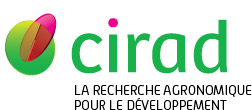Breton Frédéric, Lubis Zulkifli, Rahmaningsih Miranti, Jacquemard Jean-Charles, De Franqueville Hubert.
2009. A lignified star-shape cavity at root-bole interface: An appropriate culture chamber for Ganoderma boninense and stromatic-like structure development.
In : MPOB International Palm Oil Congress (PIPOC 2009), Kuala Lumpur, 9-12 november 2009. MPOB
|
Version publiée
- Anglais
Utilisation soumise à autorisation de l'auteur ou du Cirad. document_556876.pdf Télécharger (635kB) |
||
|
Version publiée
- Anglais
Utilisation soumise à autorisation de l'auteur ou du Cirad. ID556876_Poster.pdf Télécharger (6MB) | Prévisualisation |
Matériel d'accompagnement : 1 poster
Résumé : This study provides further information on the role of the melanised stromatic-like structure (SLS) for the initiation of Basal Stem Rot (BSR) infection in both the field and nursery. Artificial inoculation of seedlings by using Ganoderma-colonized rubber wood block (RWB) previously cleaned of SLS confirmed the essential role of this structure to induce rapid and homogeneous infections. In mature palms, whatever the sanitary condition, the presence of a highly lignified starshape cavity at the base of the bole (root-bole interface) could play a role as a culture chamber for Ganoderma development and infection. This cavity is considered to provide suitable conditions (dark, lower than ambient temperature, high humidity and a dense substrate) for the development of SLS and probably has less antagonists than in the open soil where Ganoderma is a poor competitor. A lignified scar which will develop as a future cavity has been observed in eight month-old nursery seedlings. Field observations of infected palms confirm the presence of a melanised fungal tissue inside this lignified star-shape cavity. Random observations of the initial stage of infection of young palms revealed that the development of SLS inside the cavity occurred before the penetration and colonisation of the oil palm bole. Transverse and longitudinal sections of the root-bole interface from recently infected palms seem to demonstrate that the initial point of Ganoderma penetration was confined to this lignified cavity. No initial Ganoderma penetration points were observed beyond the periphery of this star-shape cavity. The colonisation of the bole by the fungus shows a centrifugal and radial invasion from the cavity which corroborates the important role of this lignified cavity for Ganoderma penetration. These results do not exclude multiple infections from this cavity by more than one isolate. The common point between field observations of mature palm infection and a nursery inoculation tests is the prior development of SLS on a dense substrate (lignified cavity in field and RWB in nursery). The sequence of events concerning the mature bole invasion by Ganoderma proposed in this paper is discussed.
Mots-clés Agrovoc : Ganoderma, Elaeis guineensis
Mots-clés géographiques Agrovoc : Indonésie
Mots-clés complémentaires : Ganoderma boninense
Classification Agris : H20 - Maladies des plantes
Auteurs et affiliations
-
Breton Frédéric, CIRAD-BIOS-UPR Génétique palmier (IDN)
 ORCID: 0000-0002-6853-2623
ORCID: 0000-0002-6853-2623
- Lubis Zulkifli, SOCFINDO (IDN)
- Rahmaningsih Miranti, Sumatra Bioscience (IDN)
- Jacquemard Jean-Charles, CIRAD-BIOS-UPR Génétique palmier (IDN)
- De Franqueville Hubert, CIRAD-BIOS-UPR Génétique palmier (FRA)
Autres liens de la publication
Source : Cirad - Agritrop (https://agritrop.cirad.fr/556876/)
[ Page générée et mise en cache le 2024-06-27 ]




